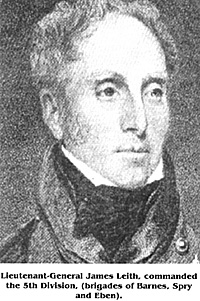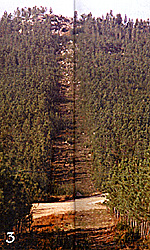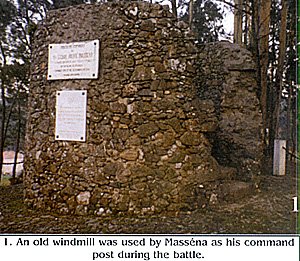The Serra de Bussaco (locally Bucaco) is a single continuous line of heights that extends nine miles north-westwards from the Mondego to the main chain of the Serra de Alcolsa. It varies in height along its length, the highest point being some 1,864 feet above sea level and almost 1,000 feet above the surrounding country-side. Three roads ran across the mountain. The central road ran from San Antonio de Cantaro to Palherios and the northern most road, which was the the only main paved road, wound its way up from the village of Moura and descended the mountain southwestwards to Coimbra.
To Wellington it was clear that if Massena chose to attack his position on the mountain it would be along either or both of these roads and he deployed his troops accordingly.

 On the extreme right of the Anglo-Portugese position, from the heights overlooking the Mondego
northwards, Wellington had placed three British brigades of the 2nd Division and Hamilton's two Portugese brigades. Hill was instructed to hold his position if attacked or if he were not engaged with the French to march northwards to the aid of Leith's 5th Division which was situated next in line almost a mile distant. Leith occupied an extended line which reached as far as the San Antonio de Cantaro Pass. Like Hill, Leith was ordered to move to his left to support the 3rd Division if he were not attacked.
On the extreme right of the Anglo-Portugese position, from the heights overlooking the Mondego
northwards, Wellington had placed three British brigades of the 2nd Division and Hamilton's two Portugese brigades. Hill was instructed to hold his position if attacked or if he were not engaged with the French to march northwards to the aid of Leith's 5th Division which was situated next in line almost a mile distant. Leith occupied an extended line which reached as far as the San Antonio de Cantaro Pass. Like Hill, Leith was ordered to move to his left to support the 3rd Division if he were not attacked.
Picton, with the 3rd Division, was stationed around the Pass on the San Antonio de Cantaro to Pahieros road. At the Passitself was Mackinnon's British brigade, with Champlemond's Portuguese brigade in support on either flank. Some 1,500 yards to the north was Picton's second British brigade, commanded by Lightbourne.
North of Picton's Division was the 1st Division followed by Pack's Portuguese brigade, and gathered around the Mortagoa to Coimbra high road was the Light Division, Coleman's Portuguese brigade, the infantry of the Kings German Legion and Campbell's Potruguese brigade. The far northern end of the line was defended by Cole's 4th Division.
Wellington also had two squadrons of the 4th Dragoons on the broad central top of the mountain. [9] There were seventy-six guns distributed along the Serra, twelve of which were situated at the San Antonio Pass under Major Arentschildt.
The centre of the Serra has a wide, flat top, some 300 or 400 yards wide, along which large bodies of all arms could move laterally with ease to support any threatened point. The right
of the position is a narrow saddleback broken at intervals with large outcrops of rock, and the rapid transfer of troops along this sector was not possible.
On the evening of the 26th the advance guards of the French 2nd and 6th Corps pushed forward to the lower slopes of the mountain, with Reynier's 2nd Corps moving across the valley to the area around the village of San Antonio de Cantaro. Reynier's voltigeurs and tiralleurs drove the light company of the British 88th Regiment from some hillocks at the foot of the heights opposite the village. Having cleared their immediate front the French settled down for the night.
The Anglo-Portuguese army slept in battle order "each man with his firelock in his grasp at his post. There were no fires and the death-like stillness that reigned throughout the line was only interrupted by the occasional challenge of an advanced sentry, or a random shot fired at some imaginary foe." [10]
By refusing to allow his troops to light any fires, Wellington gave his enemy no indication of the disposition of his forces. The French, by contrast, were well supplied with firewood and "more
than a thousand fires illuminated. their camp." [11]
After a brief recormaisance Massena issued his orders for an attack upon the mountain the following morning. "II Corps will attack the enemy's right; it will endeavour to break through the enemy's line, after scaling the most accessible point of the mountain. It will reach its objective in one or two columns preceded by skirmishers. Once it has reached the crest at the point
selected for attack, it will form up in close column and cross the mountain ridge to the Cormbra road and beyond. [12]
Marshall Ney with the 6th Corps was ordered to make his attack up the Cormbra road only when he
had seen Reynier capture the allied right and begin to move along the crest of the heights. So if Reynier failed the 6th Corps would not attack.
Before daylight on the morning of 27th September, Reynier assembled his two divisions at the foot of the Serra. He had chosen for his objective the lowest point on the hillside opposite him,
which was the dip in the ridge where the road from San Antonio crosses the mountain. Heudelet's Division was on the left straddling the road with instructions to seize the San Antonio Pass, and Merle's Division was on the right near the village of Pendura and was to attack north of the road. All the French battalions were in column with a frontage of just one company and in each regiment the battalions were drawn up one behind the other. In advance of the columns was a dense line of
skirmishers.
More San Antonio Pass
 But a short distance down the reverse side of the ridge there was a rough country track which Wellington's engineers, with the assistance of some local labour, had widened and straightened so that both infantry and artillery could be moved entirely out of sight of the enemy. The Royal Engineers had also barricaded the San Antonio de Cantaro to Palheiros road with abattis and littered it with large boulders.
But a short distance down the reverse side of the ridge there was a rough country track which Wellington's engineers, with the assistance of some local labour, had widened and straightened so that both infantry and artillery could be moved entirely out of sight of the enemy. The Royal Engineers had also barricaded the San Antonio de Cantaro to Palheiros road with abattis and littered it with large boulders.
 The 2nd Corps was still situated around the village of San Antonio de Cantaro, with Merle's
Division at the foot of the mountain in front of the village of Pendura. The cavalry brigade of
the 2nd Corps, under General Soult, was posted behind San Antonio in the direction of
Carvalho. Reynier's artillery, commanded by General Tirlet, was also stationed behind San Antonio near the Cavalry brigade. Tirlet took fourteen of his twenty-five guns and placed them on several prominent small hills opposite the Allied batteries at the San Antonio Pass.
The 2nd Corps was still situated around the village of San Antonio de Cantaro, with Merle's
Division at the foot of the mountain in front of the village of Pendura. The cavalry brigade of
the 2nd Corps, under General Soult, was posted behind San Antonio in the direction of
Carvalho. Reynier's artillery, commanded by General Tirlet, was also stationed behind San Antonio near the Cavalry brigade. Tirlet took fourteen of his twenty-five guns and placed them on several prominent small hills opposite the Allied batteries at the San Antonio Pass.
Back to Age of Napoleon 30 Table of Contents
Back to Age of Napoleon List of Issues
Back to MagWeb Master List of Magazines
© Copyright 1999 by Partizan Press.
This article appears in MagWeb (Magazine Web) on the Internet World Wide Web.
Other military history articles and gaming articles are available at http://www.magweb.com